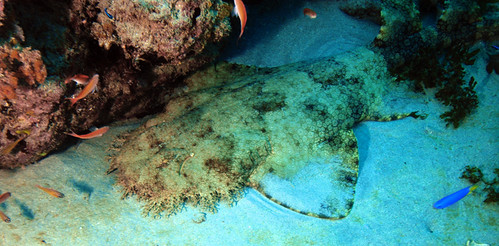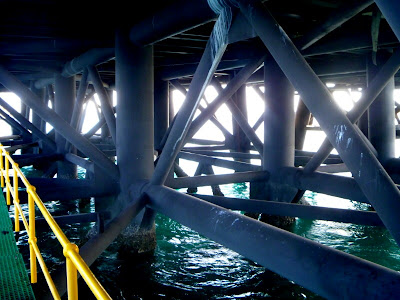I certainly saw a lot of animals today that I may never see again. Some of the species only live in this one area.
There are a few reasons that it is so densely populated. For starters, the pier is the only thing around and it provides shelter from storms, currents, etc. Secondly, the site, because it's an active naval pier, is not allowed to be fished or even approached for about 1km around. And lastly, the area has been protected for over 40 years, giving it time to get established.
Some of the animals we saw today:
- Enormous schools of giant trevally, apparently they scare off some of the sharks because there are so many.
- Barracuda and spangled emperor (hanging around with the trevally)
- Lots of friendly giant cod, bigger than me.
- A moray eel with the circumference of a soccer ball. (There were lots of morays, neon green ones, white ghost morays.)
- Sharks. Probably a dozen or so white tipped reef sharks, I inadvertently came within a meter or so of one (whoops).
- Wobbegon sharks, two of then.
- Two octopi, a grey one and a black one, smallish.
- A frog fish and a stone fish.
- Bat fish, no doubt hiding from the trevally.
- Lionfish bigger that a rugby ball.
- Oddly coloured nudibranch.
- Huge parrot fish (though I think the site could use some more as the fire weed is getting out of control.)
- Black catfish like creatures with the body of an eel.
- Large shoals of tiny fish and lots of other finned critters I just can't name.
I have mixed feelings about this dive site though. The visibility is so-so. Our dive had about 7 meters. Also, the pier itself casts a shadow making it dark too. Because the pier is very solidly built with large crisscrossing beams, it essentially creates confined spaces about 5 meters square. If you have buoyancy control problems or are unable to swim with just your fins, then this will be a problem. To make things more challenging, there is almost always some current and it's important to time the dive just right. When we started our dive the current was so strong you had to swim hard to stay in one spot.
A good video snippet of the area
 |
| A wobbegon shark (ours had a little less beard) |
The entrance (those are towers for VLF communication with submarines)
A side dolphin
The support beams, which continue below the surface.


















































